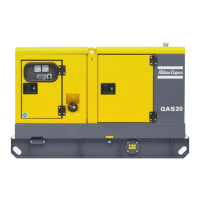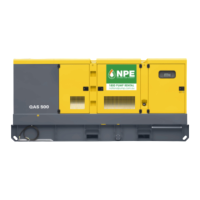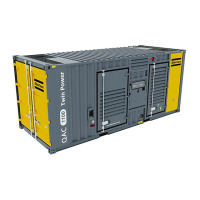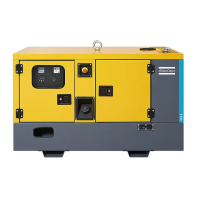INSTRUCTION MANUAL
13
23(5$7,1*,16758&7,216
QAS28 Yd(S)
QAS28 YdS IT
,
167$//$7,21
– Place the generator on a horizontal, even and solid floor.
– Protect the generator against dust and rain if it is operated outside.
– Check that the engine exhaust is not directed towards people. If the
generator is operated indoors, install an exhaust pipe of sufficient
diameter to duct the engine exhaust towards the outside. Check for
sufficient ventilation so that the cooling air is not recirculated. If
necessary, consult Atlas Copco.
– Leave enough space for operation, inspection and maintenance (at
least 1 meter at each side).
– Check that the inner earthing system is in compliance with the local
legislation.
– Use coolant for the engine cooling system. Refer to the Engine in-
struction book for the proper coolant mixture.
– Check the tightness of the bolts and nuts.
QAS28 Yd(S)
– Install the earthing rod as near as possible to the generator and mea-
sure its diffusion resistance (max. 1 kΩ) in order not to have a con-
tact voltage higher than 25 V at 30 mA leakage current.
– Check that the cable end of the earthing rod is connected to the earth
terminal.
QAS28 YdS IT
– Check the setting of the insulation monitoring relay (factory set at
13 kΩ
In your own interest, always strictly observe all rele-
vant safety instructions.
Do not operate the generator in excess of the limita-
tions mentioned in the Technical Specifications.
Local rules concerning the setting up of low voltage
power installations (below 1,000 V) must be
respected when connecting site distribution panels,
switch gear or loads to the generator.
At each start-up and at any time a new load is con-
nected, the earthing of the generator must be veri-
fied. Earthing must be done either by the earthing
rod or, if available, by an existing, suitable earthing
installation. The protective system against excessive
contact voltage is not effective unless a suitable
earthing is made.
The generator is wired for a TN-system to IEC 364-
3, i.e. one point in the power source directly earthed
- in this case the neutral. The exposed conductive
parts of the electric installation must be directly con-
nected to the functional earth.
If operating the generator in another power system,
e.g. an IT-system, other protective devices required
for these types must be installed. In any case only a
qualified electrician is authorized to remove the con-
nection between the neutral (N) and earth terminals
in the terminal box of the alternator.
At each start-up and any time a new load is con-
nected, the insulation resistance must be verified.
Check for the correct setting of the insulation moni-
toring relay.
The generator is wired for an IT network i.e. no sup-
ply lines of the power supply are directly earthed. A
failure in insulation resulting in too low an insula-
tion resistance, is detected by the insulation monitor-
ing relay.
The generator shall not be operated with other net-
works (such as TT or TN). Doing so will cause trip-
ping of the insulation monitoring relay.
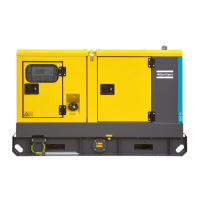
